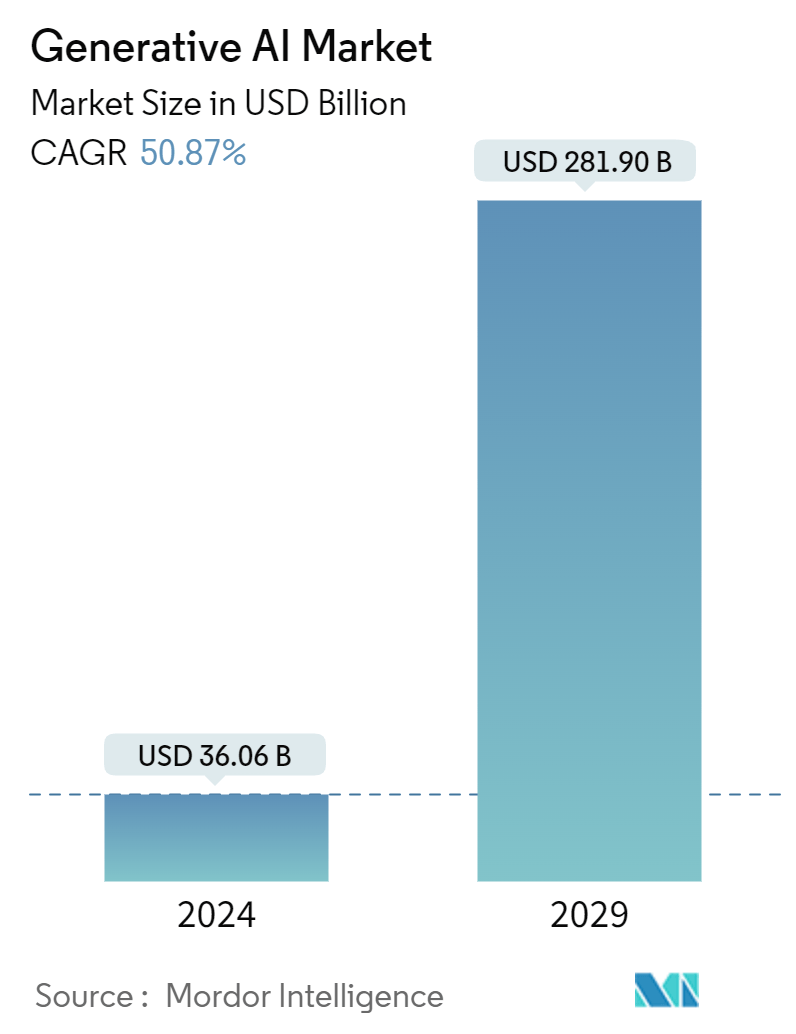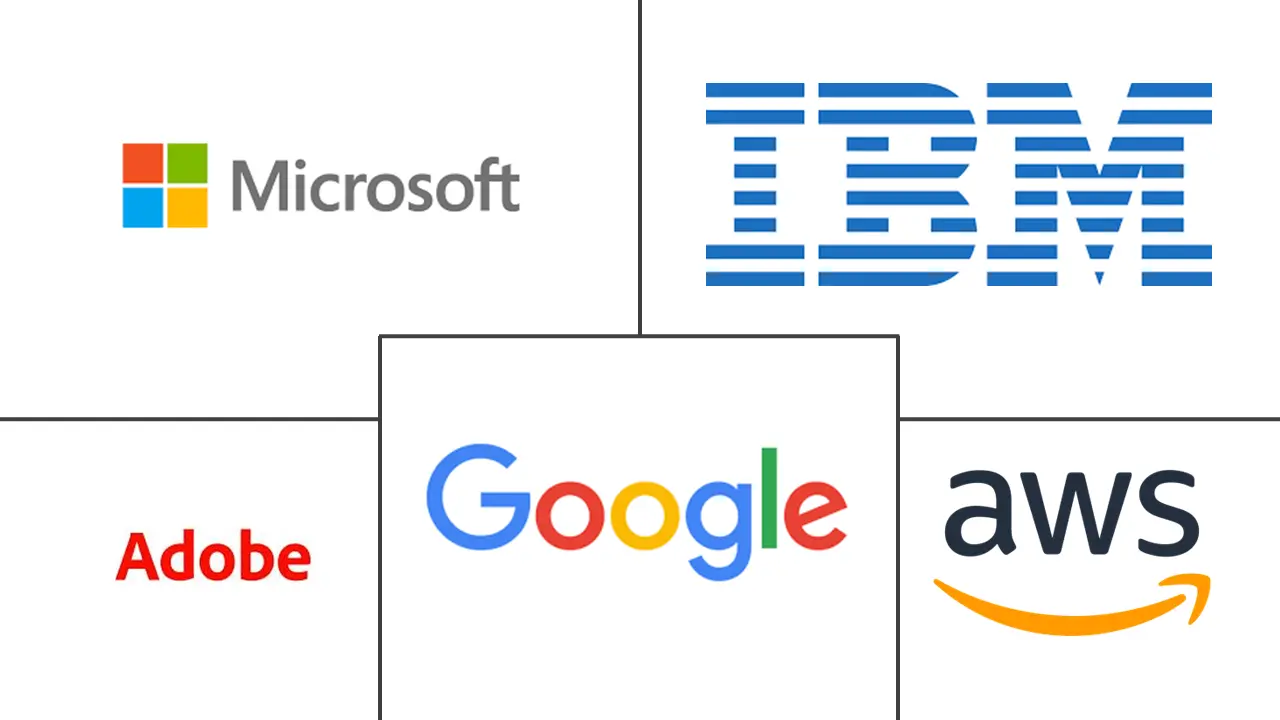Market Size of Generative AI Industry

| Study Period | 2019 - 2029 |
| Market Size (2024) | USD 36.06 Billion |
| Market Size (2029) | USD 281.90 Billion |
| CAGR (2024 - 2029) | 50.87 % |
| Fastest Growing Market | Asia Pacific |
| Largest Market | North America |
Major Players
*Disclaimer: Major Players sorted in no particular order |
Generative AI Market Analysis
The Generative AI Market size is estimated at USD 36.06 billion in 2024, and is expected to reach USD 281.90 billion by 2029, growing at a CAGR of 50.87% during the forecast period (2024-2029).
- The market is primarily propelled by the expanding information technology (IT) sector and the growing use of AI-integrated systems for improving productivity and agility. Besides this, generative AI's ever-increasing popularity for aiding chatbots in conducting effective conversations and enhancing consumer satisfaction also propels the market’s growth. Generative AI can construct personalized recommendations, tailored advertisements, and customized products based on individual choices and behavior. Moreover, the increasing utilization of generative AI for making virtual worlds in the metaverse, producing digital artworks using text-based descriptions, and generating unique and innovative content is also pushing the market forward. Furthermore, the market has drawn significant investments and funding from established businesses and venture capitalists.
- Generative AI allows models to evolve multimodal, which implies they can process multiple modalities simultaneously, such as images and text, widening their application areas and improving their versatility. Generative AI enhances the connection to the globe where humans communicate with computers, utilizing natural language rather than programming languages. Generative AI can transform businesses by opening new opportunities for automation, innovation, and personalization, all while lowering costs and improving customer experience. For instance, in March 2023, Grammarly, Inc., an AI-based writing assistant, announced the launch of GrammarlyGo, a feature of generative AI that allows users to compose writing, edit, and personalize text.
- GANs have found applications in numerous fields and enterprises, making them highly adaptable. They are utilized in image synthesis, style transfer, image-to-image translation, text generation, video generation, data augmentation, and more. The ability of GANs to develop new, diverse, and realistic models has made them a go-to choice for various generative tasks, driving the market studied. Moreover, the availability of open-source implementations and pre-trained GAN models have facilitated the adoption and usage of GANs. These resources, integrated with easy-to-use libraries and frameworks like PyTorch and TensorFlow, have lowered the obstacle to entry for designers and researchers, letting them leverage GANs for their applications without starting from scratch.
- Medical research depends on accessing vast amounts of data on different health conditions. This data needs to be improved, especially regarding rare diseases. Such data is also expensive, and privacy laws govern its usage and sharing. Generative AI in medicine can produce synthetic data samples that augment real-life health datasets. These samples are not subject to privacy regulations, as healthcare data does not belong to particular individuals. Artificial intelligence can develop EHR data, scans, etc. For example, a team of German researchers built an AI-powered model, GANerAid, to generate synthetic patient data for clinical trials. This model is based on the GAN procedure and can create medical data with the desired properties even if the training dataset is limited.
- Generative AI solutions allow organizations to understand their compliance-related issues and data management better. Software tools enable AI-enabled solutions to extract a large amount of data on time and produce accurate and complete data. There is a surge in the trend where a significant number of companies are increasingly demanding AI-based solutions. Moreover, multiple industries are witnessing a considerable increase in startups. These new players are highly attracted to adopting AI to automate and expand their businesses. AI-based solutions are mainly deployed due to their cost and time efficiency, improved user experience, ease of use, and new features with advanced technology.
- On the contrary, artificial intelligence can potentially solve common business challenges. Still, privacy concerns are popping up, and firms feed consumer and vendor data into advanced, AI-fueled algorithms to create new sensitive information. Security and privacy concerns are among the key challenges in the digital transformation market. As firms rely more on digital technology, they collect and store enormous volumes of sensitive data, making them vulnerable to cyberattacks and data breaches. Furthermore, as the number of connected devices rises, hackers' attack surface expands, making it more challenging to secure these devices and the data they collect and transmit.
Generative AI Industry Segmentation
Generative AI is a set of algorithms that generate seemingly new, realistic content such as text, images, or audio from the training data. The most potent generative AI algorithms are built on foundation models trained on a vast quantity of unlabeled data in a self-supervised way to determine underlying patterns for a wide range of tasks.
The generative AI market is segmented by offering (solutions and services), end-user industry (BFSI, healthcare, IT and telecommunication, government, retail and consumer goods, and other end-user industries), and geography (North America, Europe, Asia-Pacific, Latin America, and Middle East and Africa). The report offers market size and forecasts in value (USD) for all the above segments.
| By Component | |
| Software | |
| Services |
| By End User | |
| BFSI | |
| Healthcare | |
| IT and Telecommunication | |
| Government | |
| Retail and Consumer Goods | |
| Other End-user Industries |
| By Geography*** | |
| North America | |
| Europe | |
| Asia | |
| Australia and New Zealand | |
| Latin America | |
| Middle East and Africa |
Generative AI Market Size Summary
The generative AI market is experiencing rapid expansion, driven by the burgeoning information technology sector and the increasing integration of AI systems to enhance productivity and agility. This technology is gaining traction for its ability to improve customer interactions through chatbots, offering personalized recommendations, and creating customized content. The market is further bolstered by its applications in the metaverse, digital art, and content generation, attracting significant investments from both established companies and venture capitalists. Generative AI's capability to process multiple data types simultaneously, such as images and text, is broadening its application scope, making it a transformative force in various industries by enabling automation, innovation, and cost-effective solutions.
In the financial sector, generative AI is poised to revolutionize risk management and wealth management processes, allowing for more strategic decision-making and enhanced fraud detection. The technology's adoption is supported by its ability to analyze historical data and simulate economic scenarios, thereby preserving profitability and managing risks effectively. North America leads in generative AI research and development, with substantial investments and a favorable environment for technological adoption. The market is semi-consolidated, with major players like Google, IBM, and Microsoft actively expanding their capabilities through strategic partnerships and collaborations. These developments are expected to drive significant growth in the generative AI market over the forecast period.
Generative AI Market Size - Table of Contents
-
1. MARKET INSIGHTS
-
1.1 Market Overview
-
1.2 Market Ecosystem Analysis
-
1.3 Industry Attractiveness - Porter's Five Forces Analysis
-
1.3.1 Bargaining Power of Buyers
-
1.3.2 Bargaining Power of Suppliers
-
1.3.3 Threat of New Entrants
-
1.3.4 Threat of Substitutes
-
1.3.5 Intensity of Competitive Rivalry
-
-
1.4 Impact of Macro Economic Factors on the Market
-
1.5 Case Study Analysis
-
-
2. MARKET SEGMENTATION
-
2.1 By Component
-
2.1.1 Software
-
2.1.2 Services
-
-
2.2 By End User
-
2.2.1 BFSI
-
2.2.2 Healthcare
-
2.2.3 IT and Telecommunication
-
2.2.4 Government
-
2.2.5 Retail and Consumer Goods
-
2.2.6 Other End-user Industries
-
-
2.3 By Geography***
-
2.3.1 North America
-
2.3.2 Europe
-
2.3.3 Asia
-
2.3.4 Australia and New Zealand
-
2.3.5 Latin America
-
2.3.6 Middle East and Africa
-
-
Generative AI Market Size FAQs
How big is the Generative AI Market?
The Generative AI Market size is expected to reach USD 36.06 billion in 2024 and grow at a CAGR of 50.87% to reach USD 281.90 billion by 2029.
What is the current Generative AI Market size?
In 2024, the Generative AI Market size is expected to reach USD 36.06 billion.

